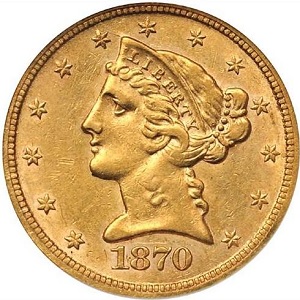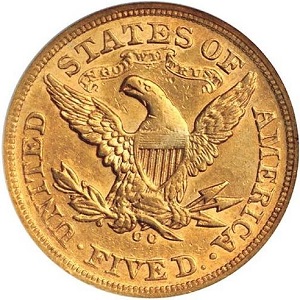1870-CC Coronet $5 Half Eagle
In 1839, the Coronet half eagle made its debut. Designed by Christian Gobrecht, this coin is often called the Liberty Head type. In 1866, the coin’s appearance was modified by adding the motto IN GOD WE TRUST above the eagle on the reverse. The Coronet half eagle was issued every year through 1908.(1)
A man named Abraham “Abe” Curry started up a settlement in 1858 along the western edge of the Nevada Territory. Curry named his small town “Carson City.”
Shortly thereafter, just a few miles away, some of the largest gold and silver deposits in North America were discovered. The fabulous find, known as the Comstock Lode, attracted thousands of fortune seekers into the area, transforming little dusty Carson City into a booming frontier metropolis.
When Nevada was awarded statehood in 1864, Carson City was selected as the seat of state government. Eventually, a U.S. branch mint facility was built there as well.
The Carson City Mint officially commenced coinage operations on January 8, 1870. Abraham “Abe” Curry, the man who worked so hard to bring a mint to the western Nevada town, was named the first superintendent of the facility.(2)
Gold coinage production at the neophyte mint did not get off to a rousing start. Only 17,372 gold coins bore the “CC” mintmark in 1870, of which 7,675 were $5 half eagles. Contrast that to the established San Francisco Mint, where over one million gold coins (mostly $20 double eagles) were struck during the same timeframe.(3)
As was true with all early Carson City coinage, the 1870-CC half eagles were plunged into the regional economy, where they served dutifully for many years, but would ultimately suffer a high attrition rate. Few were saved by collectors of the time, explaining why there are only an estimated 77 survivors for clamoring numismatists today.(4)
It wasn’t until after the turn of the century when the 1870-CC half eagle became acknowledged (sort of) as a collectible. In a 1911 sale, auctioneer B. Max Mehl describe lot 663 as "1870 First Half Eagle of this [CC] mint. Very fine. Rare." It sold for $6.75.(5) That same coin, if graded as a VF-20, could sell in the current marketplace for about $40,000.(6)
Only one die pair was used to strike all the 1870-CC half eagles, but it is important to note there are two die states. Die State I displays sharp definition of the central design elements of both sides of the coin. Die State II shows obvious weakness in the same spots.
These die states probably did not occur because of die wear. The distinct die states most likely occurred due to improper machine set up during one or more of the batch runs. Either the top and bottom dies were spaced too far apart or the pressure setting on the machine was not correct. Only about 25% of the survivors display the sharpness of Die State I: these examples usually command premiums at selling time.(7)
Fascinating Fact: One of the finest known examples of an 1870-CC half eagle was spotted protruding from the ground in 1994 by a Carson City mailman working his route. He sold it to a local coin dealer whose shop was across the street from the former mint building (now a museum). Eventually, the coin was certified as MS-61 (Die State I) and sold at auction in 2012 for $105,750.(8)
For the discerning collector, there appears to be no downside risk in owning an 1870-CC Coronet half eagle. We have charted value trend records back to 1950, and it’s impossible to find evidence of a sustained price slump or irrational price hikes. Instead, values just keep going Up, Up, and Up! This is to be expected for a great rarity that also carries the allure of the Old West, an attraction many coin hobbyists find irresistible.
| Estimated survivors in all grades: 77 ?
The survivor estimate from PCGS represents an average of one or more experts' opinions as to how many examples survive of a particular coin in all grades. Survival estimates include coins that are raw, certified by PCGS, and certified by other grading services. Learn more at PCGS. |
| PCGS Rarity Scale: 8.2 ?
The 'PCGS CoinFacts Rarity Scale' assesses the relative rarity of all U.S. coins, based on estimated surviving examples. The scale runs from 1.0 to 10.0. The higher the number, the rarer the coin.
Learn more at PCGS. |
| Click HERE to check for availability on eBay** |
Preview of eBay selection (on super rare coins like this one, the HERE link may yield better results than the Preview):
 |
 |
| Trendline Avg = 24.81 | BETTER |
Historic Value Trend Charts:
| Last updated 8-7-24 | Return to Key Date Coin List | |
| Compare to Common Date Coin of Same Type | ||
|
|
||
| Download Charts to Your Computer | ||
Sources
1. Yeoman, R.S. and Garrett, Jeff, et al. A Guide Book of United States Coins, 75th ed. Pelham, AL: Whitman Publishing, 2021.
2. Stack's Bowers Galleries. 1870-CC Liberty Half Eagle. Die State II. Aug 2021 Auction.
3. Yeoman, R.S. and Garrett, Jeff, et al. A Guide Book of United States Coins, 75th ed. Pelham, AL: Whitman Publishing, 2021.
4. PCGS. 1870-CC $5 (Regular Strike).
5. Heritage Auctions. 1870-CC $5. Jan 2020 Auction.
6. Gibbs, William T., Managing Editor. Coin World Domestic Values. Sidney, OH. Amos Media Company. 2023.
7. Heritage Auction. 1870-CC $5. Jan 2022 Auction.
8. Stack's Bowers Galleries. 1870-CC Liberty Half Eagle. Die State I. Aug 2012 Auction.
**Many very fine coin dealers sell on eBay. At any point in time, there may be over one million search results for United States coins. This includes quite a few of the recommendations on our Key Date Coin List.
If you’re thinking about purchasing a rare coin, eBay is certainly worth a look. For your convenience, the links from this site to eBay are coded to bring up only coins certified by PCGS and NGC.
As is always, always the case, never buy a valuable coin from a seller whose trustworthiness cannot be verified. Learn more about this at our chapter Best Places to Buy Coins, which also has a section on doing business on eBay.
In the interest of full disclosure, Rare Coins 101 receives a small commission anytime someone connects to eBay from this site and purchases something.
Coin images by Stack's Bowers Galleries.


